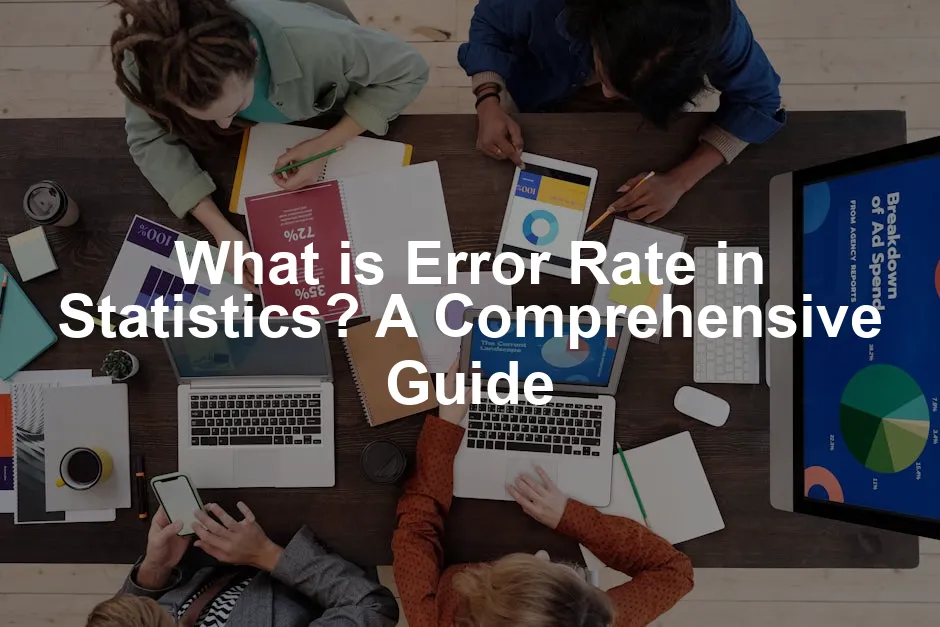Introduction
In statistics, the error rate is a crucial concept that quantifies the likelihood of making incorrect conclusions based on data analysis. Simply put, it refers to the frequency of errors in a statistical process. Understanding error rates helps researchers and analysts make informed decisions, minimize risks, and improve the accuracy of their findings. If you’re looking to dive deeper into the world of statistics for data science, check out Statistics for Data Science: A Complete Guide to Statistics for Data Science.

Understanding how to utilize error rates is essential for making informed decisions using data.
Error rates play a vital role in data analysis, decision-making, and hypothesis testing. They allow researchers to gauge the reliability of their results and to adjust their methods accordingly. For instance, in medical research, a high error rate can result in misdiagnoses, leading to severe consequences for patients. Similarly, in finance, incorrect predictions can result in substantial financial losses. Thus, monitoring and managing error rates is essential across various fields. If you’re keen on understanding statistical learning, don’t miss Introduction to Statistical Learning with Applications in R.
There are two primary types of errors associated with statistical tests: Type I and Type II errors. A Type I error, also known as a false positive, occurs when a true null hypothesis is incorrectly rejected. This means that the analysis suggests a significant effect when none exists. In contrast, a Type II error, or false negative, happens when a false null hypothesis is not rejected. This leads to the failure to detect an actual effect. Both error types have significant implications for research outcomes and can affect the credibility of the results.

This article will delve into a comprehensive understanding of error rates in statistics. We will begin by defining error rates, their significance in various fields, and the types of error rates. Following this, we will explore how to calculate error rates, the implications of these calculations in hypothesis testing, and strategies for managing error rates effectively. By the end of this guide, you will have a thorough understanding of error rates and their importance in statistical analysis.
Understanding Error Rate: Definitions and Types
What is an Error Rate?
An error rate, in statistical terms, is the proportion of errors made in a specific context. It quantifies the frequency of incorrect outcomes relative to the total number of observations. For example, in a medical diagnostic test, the error rate indicates how often the test yields incorrect results. This metric can be expressed as a percentage, making it easy to grasp and communicate. To further enhance your understanding of data science and statistics, consider reading The Data Science Handbook.

The significance of error rates stretches across various fields. In healthcare, accurate diagnoses are paramount; thus, understanding the error rate can help in refining diagnostic tests. In finance, analysts rely on error rates to evaluate the performance of predictive models, ensuring that investment decisions are based on reliable forecasts. Similarly, in technology, error rates are crucial in assessing the reliability of software systems and algorithms.
By keeping track of error rates, professionals can identify areas for improvement. For instance, if a particular test consistently shows a high error rate, it may require reevaluation or redesign. This proactive approach can lead to enhanced accuracy, reduced costs, and improved outcomes. If you’re interested in mastering the art of data science, check out Data Science for Business: What You Need to Know About Data Mining and Data-Analytic Thinking.
Types of Error Rates
Type I Error (False Positive)
A Type I error occurs when a true null hypothesis is incorrectly rejected, leading to the conclusion that an effect exists when it does not. This false positive can have serious implications, especially in fields like medicine. For example, if a new drug is deemed effective based on a Type I error, patients may be subjected to unnecessary treatments, potentially leading to adverse effects. To better navigate these pitfalls, consider reading How to Measure Anything: Finding the Value of “Intangibles” in Business.

In various contexts, Type I errors can vary in frequency. In clinical trials, researchers often set a significance level (alpha, α) to control the Type I error rate. A common alpha level is 0.05, indicating a 5% risk of committing a Type I error. Understanding the contexts where Type I errors are likely to occur helps researchers implement better controls and minimize risks.
Recognizing and mitigating Type I errors is crucial in maintaining the integrity of research findings. Strategies such as adjusting the significance level or employing rigorous testing protocols can help control these errors, ensuring that conclusions drawn from data are reliable and valid. If you want to explore data mining techniques, consider Data Mining: Concepts and Techniques.
Type II Error (False Negative)
A Type II error, also known as a false negative, occurs when researchers fail to reject a false null hypothesis. In simpler terms, it’s when you think nothing is happening, but in reality, something significant is going on. Imagine you’re at a party, and you’re convinced it’s boring, yet the dance floor is buzzing. You miss out on all the fun! If you’re looking for insightful perspectives in statistics, don’t miss The Art of Statistics: Learning from Data by David Spiegelhalter.
Common situations leading to Type II errors often arise in medical testing. For instance, consider a cancer screening test. If the test indicates no signs of cancer (a false negative), the patient may leave thinking they’re healthy when, in fact, they need treatment. This kind of oversight can have serious consequences.
Take the example of a new drug trial. If the study fails to detect the drug’s effectiveness, it might lead to a conclusion that the drug is useless. Meanwhile, patients who could benefit from it might not receive the treatment they need. If you’re interested in the intersection of data science and healthcare, you might enjoy The Black Swan: The Impact of the Highly Improbable by Nassim Nicholas Taleb.
In education, think about a standardized test that fails to identify a student needing extra help. A Type II error here could prevent a child from receiving the support necessary to succeed.

In summary, Type II errors can result in missed opportunities and critical oversights. They lead to incorrect conclusions that may affect patient health, educational outcomes, and even business decisions. In the world of statistics, it’s essential to remain vigilant against these sneaky errors that can slip through the cracks.
The Trade-off Between Type I and Type II Errors
Understanding the relationship between Type I and Type II errors is crucial for effective hypothesis testing. When you adjust the significance level (alpha), you’re essentially playing a balancing act. Lowering the alpha reduces the chances of a Type I error, but it often increases the likelihood of a Type II error. It’s like trying to catch a ball while riding a unicycle—you have to maintain your balance to stay upright! If you’re looking for practical guidance in data science, consider Practical Statistics for Data Scientists: 50 Essential Concepts.

In hypothesis testing, the significance level (alpha) represents the threshold at which you decide to reject the null hypothesis. For instance, if you set alpha at 0.05, you’re saying you’re willing to accept a 5% chance of making a Type I error. But here’s the catch: as you tighten this threshold, you might overlook genuine effects, increasing the risk of Type II error.
Consider a clinical trial study evaluating a new medication. If the researchers set a very stringent alpha level to avoid false positives, they might conclude that the drug is ineffective when it truly works. This is a classic case of Type II error—missing out on a treatment that could help patients.
The trade-off between these two error types plays a significant role in statistical decision-making. Researchers must weigh the consequences of each error type in their specific context. Sometimes, a Type I error may be deemed more serious, while in other scenarios, a Type II error can have more severe implications. Assessing the risks associated with each error helps scientists and statisticians determine the most appropriate alpha level for their studies.
In summary, understanding the interplay between Type I and Type II errors is vital for making informed decisions in research. It’s all about finding that sweet spot where you minimize the risk of both while ensuring reliable and valid outcomes.

Calculating Error Rates
How to Calculate Type I Error Rate
To calculate the Type I error rate, we need to focus on the probability of incorrectly rejecting a true null hypothesis. The formula is straightforward:
\[
\text{Type I Error Rate} (α) = \frac{\text{Number of False Positives}}{\text{Total Number of Hypotheses Tested}}
\]Let’s say you conduct an experiment testing a new drug, where you test 100 hypotheses. You find that 5 of them indicate a significant effect when there is none. To find the Type I error rate, you plug your numbers into the formula:
\[
α = \frac{5}{100} = 0.05 \text{ or } 5\%
\]
This means you have a 5% chance of making a Type I error. This rate can be critical in research, especially in fields like medicine, where the implications of false positives can lead to unnecessary treatments or interventions. If you’re interested in understanding more about data analysis, consider picking up Data Analysis with Python and PySpark.
In practice, calculating the Type I error rate helps researchers understand how often they might incorrectly conclude that an effect exists. For example, if a clinical trial sets a significance level of 0.05, they are essentially saying they are okay with a 5% chance of concluding that a drug is effective when it is not.

Using the Type I error rate in research designs can help determine sample sizes, adjust alpha levels, and refine study parameters. Ultimately, understanding how to calculate the Type I error rate is essential for researchers to make informed decisions and enhance the reliability of their findings. If you’re looking for a comprehensive resource, check out The Data Warehouse Toolkit: The Definitive Guide to Dimensional Modeling.
How to Calculate Type II Error Rate
Calculating the Type II error rate, denoted as β (beta), is essential in hypothesis testing. It represents the probability of failing to reject a false null hypothesis. The formula to determine the Type II error rate is:
\[
\text{Type II Error Rate} (β) = 1 - \text{Power}
\]Where power refers to the probability of correctly rejecting a false null hypothesis. To effectively measure Type II error rates, several factors must be considered:
- Sample Size: Larger sample sizes generally lead to higher power, thus reducing the Type II error rate. A small sample may not capture the true effect.
- Effect Size: The larger the effect size, the easier it is to detect. A small effect size can result in a higher Type II error rate.
- Significance Level (α): Lowering the significance level increases the risk of Type II errors. Thus, balancing α and β is crucial in research design.

For example, let’s say you want to test a new drug’s effectiveness. You set a significance level of 0.05 and determine that the power of your test is 80%. Using the formula:
\[
β = 1 - 0.80 = 0.20
\]This means there is a 20% chance of not detecting the drug’s effectiveness if it indeed exists. This insight highlights the importance of determining an appropriate sample size and effect size to minimize Type II errors. For further reading, consider Python for Data Analysis by Wes McKinney.
Factors Influencing Error Rates
Error rates in statistical tests are influenced by various factors. Understanding these can help mitigate risks in hypothesis testing.
- Sample Size: A larger sample size diminishes the margin of error, increasing the test’s power and reducing both Type I and Type II error rates. Conversely, a small sample can lead to unreliable results.
- Significance Level (α): The alpha level determines how much risk you’re willing to take for Type I errors. A strict alpha level may increase Type II errors, as it makes it harder to reject the null hypothesis.
- Study Design: The way a study is structured can affect error rates. Randomized controlled trials tend to yield more reliable results compared to observational studies, which can introduce bias.
- Power Analysis: Conducting a power analysis before a study helps in minimizing Type II errors. It assesses the likelihood of detecting an effect based on sample size, effect size, and significance level. A power level of 80% or higher is often recommended to ensure reliable results.

In summary, to minimize error rates in hypothesis testing, researchers should carefully consider their sample size, significance level, and study design. Power analysis is a valuable tool in this process, ensuring that the tests used are robust enough to detect true effects while maintaining a reasonable balance between Type I and Type II errors. If you’re interested in a comprehensive guide for data science, you might want to check out The Complete Guide to Data Science.
Strategies for Controlling Error Rates
Controlling error rates is essential in research. It ensures conclusions drawn are reliable and valid. Two popular methods for managing error rates are the Bonferroni correction and the Holm correction.

The Bonferroni correction is a straightforward approach. This method divides the significance level (alpha) by the number of tests conducted. For example, if you’re testing five hypotheses with an initial alpha of 0.05, the new alpha level for each test would be 0.01. This helps keep the overall error rate in check. However, this method can be overly conservative, leading to missed discoveries. If you want to delve deeper into statistical programming, consider A First Course in Statistical Programming with R.
On the other hand, the Holm correction is a sequential method. Researchers rank their p-values from lowest to highest and adjust them based on their rank. It’s less conservative than Bonferroni and allows for a more flexible approach to error control. Both methods emphasize the importance of careful consideration when interpreting results.
In addition to these corrections, designing experiments with reduced error potential is crucial. Well-structured experiments minimize the chances of making incorrect conclusions. For instance, using larger sample sizes can enhance the reliability of results. Researchers should also consider the complexity of the study design, aiming to avoid unnecessary variables that could introduce errors. If you’re curious about data analysis tools, check out Data Analysis with Open Source Tools.
Overall, controlling error rates not only improves the quality of research but also fosters trust in scientific findings.

Real-world Applications of Error Rates
Error rates play a significant role across various fields, influencing decision-making processes. In clinical trials, for example, a Type I error can lead to the approval of ineffective drugs. This can result in patients receiving treatments that do nothing for their conditions. Conversely, a Type II error could prevent an effective treatment from reaching those who need it. If you want to learn more about data science principles, consider The Data Science Book: The Definitive Guide to Data Science.
Take the case of a clinical trial for a new cancer drug. If the trial results suggest the drug is ineffective (Type II error) when it’s actually beneficial, patients may miss out on a life-saving treatment. This exemplifies how high error rates can have dire consequences in healthcare.

In quality control, manufacturing processes rely heavily on error rate management. A high error rate in production can result in defective products reaching consumers. This not only affects customer satisfaction but can also lead to financial losses and damage to a company’s reputation. Efficient error rate management is critical in these scenarios, ensuring products meet safety and quality standards.
In finance, error rates can impact risk assessment and investment decisions. Incorrect predictions can lead to substantial losses for investors and companies alike. For example, if a financial model underestimates the risks associated with a particular investment, it could result in a failed investment strategy. If you’re interested in exploring innovative business solutions, check out The Lean Startup: How Today’s Entrepreneurs Use Continuous Innovation to Create Radically Successful Businesses.
These examples illustrate the far-reaching implications of error rates in real-world applications. Understanding and managing these rates is crucial for informed decision-making and successful outcomes.
Conclusion
Understanding error rates in statistics is essential for researchers and analysts alike. It allows them to navigate the complexities of data analysis and make informed decisions. Throughout this article, we explored the definition of error rates and examined the significance of Type I and Type II errors.
We discussed strategies for controlling these error rates, such as the Bonferroni and Holm corrections. Each method offers unique advantages and challenges, emphasizing the need for careful consideration in experimental design. Additionally, we highlighted real-world applications of error rates in fields like healthcare, manufacturing, and finance.
Recognizing the consequences of high error rates is vital. In clinical trials, a Type I error can lead to ineffective drugs being approved, while a Type II error may prevent beneficial treatments from being utilized. In manufacturing, unchecked error rates can compromise product quality, resulting in financial losses and reputational damage. The stakes are high, and effective management of error rates is paramount. If you’re looking for an engaging analysis of data science, consider Data Science from Scratch: First Principles with Python by Joel Grus.
As you embark on your research and data analysis, keep these insights in mind. Strive to minimize errors in your work by employing appropriate methods and designing robust experiments. By doing so, you’ll contribute to more reliable outcomes and enhance the credibility of your findings. Understanding and managing error rates is not just a statistical exercise; it’s a commitment to excellence in research and decision-making.
FAQs
What is the difference between Type I and Type II errors?
Type I and Type II errors are critical concepts in statistics, especially in hypothesis testing. A Type I error, also known as a false positive, occurs when a researcher rejects a true null hypothesis. Imagine a court convicting an innocent person; that’s a Type I error! On the flip side, a Type II error, or false negative, happens when a researcher fails to reject a false null hypothesis. Picture a jury acquitting a guilty person. Both errors have real-world consequences and can significantly affect research outcomes. The key difference lies in their implications: Type I errors represent a false alarm, while Type II errors mean missing a genuine effect. Thus, understanding these types helps researchers balance the risks involved in testing hypotheses.
How can I reduce the risk of making a Type I error?
Reducing the risk of Type I errors is crucial for maintaining research integrity. Here are several strategies to consider: 1. Set a Lower Significance Level: Adjust your alpha level. Instead of the common 0.05, consider using 0.01 or even 0.001. This makes it harder to reject the null hypothesis, thus lowering Type I error chances. 2. Bonferroni Correction: If you’re testing multiple hypotheses, use the Bonferroni correction. This method divides the alpha level by the number of tests to ensure that the overall error rate remains low. 3. Replicate Studies: Conducting studies multiple times helps verify results. If findings consistently show significance, the chances of a Type I error decrease. 4. Pre-registration of Studies: Pre-registering your hypotheses and analysis plans can minimize the temptation to manipulate data after the fact, which often leads to Type I errors. 5. Use Larger Sample Sizes: Larger samples reduce variability, making it easier to identify true effects while minimizing the risk of false positives. By implementing these strategies, researchers can significantly lower the risk of Type I errors, ensuring more reliable conclusions.
What is the significance level, and how does it affect error rates?
The significance level, denoted as alpha (α), is a threshold that determines when to reject the null hypothesis. It reflects the probability of committing a Type I error. For example, an alpha of 0.05 implies a 5% chance of incorrectly rejecting the null hypothesis. Choosing a significance level balances the trade-off between Type I and Type II errors. A lower alpha decreases the likelihood of Type I errors but increases the chance of Type II errors. Conversely, a higher alpha increases Type I error risk while reducing Type II error probability. Researchers must carefully consider their field’s context when setting this level. For instance, in medical research, preventing false positives might be more critical than in exploratory studies. Therefore, the significance level plays a crucial role in shaping the outcomes and reliability of statistical analyses.
Why is it important to understand error rates in statistics?
Understanding error rates is vital for researchers and decision-makers. These rates highlight the reliability of conclusions drawn from data analysis. If researchers overlook error rates, they risk making misguided decisions based on flawed data. In fields like healthcare, a high Type I error rate could lead to unnecessary treatments or interventions, putting patients at risk. In finance, inaccuracies can result in significant monetary losses. Awareness of error rates fosters transparency and accountability in research. Moreover, understanding these errors helps in designing better studies. Researchers can implement strategies to minimize these risks, improving the overall quality of their findings. In essence, error rates are not just statistics; they are crucial indicators that guide informed decision-making across various disciplines.
How does sample size affect error rates?
Sample size plays a critical role in determining error rates. Larger sample sizes typically lead to lower error rates, enhancing the reliability of results. Here’s how: 1. Reduced Variability: Larger samples capture a more accurate representation of the population. This minimizes the effects of random variability, making it easier to detect true effects. 2. Increased Power: A bigger sample size increases the statistical power of a test. With greater power, the chances of correctly rejecting a false null hypothesis (reducing Type II error) improve. 3. Stability of Estimates: Larger samples provide more stable estimates of parameters. This stability leads to more accurate p-values and a reduced likelihood of making errors. 4. Balancing Type I and II Errors: While larger samples help reduce Type II errors, they can also be adjusted to control Type I errors by allowing for more stringent significance levels. In summary, larger sample sizes can significantly enhance the reliability of research outcomes, making them essential for minimizing error rates in statistical analysis.
Please let us know what you think about our content by leaving a comment down below!
Thank you for reading till here 🙂
All images from Pexels




